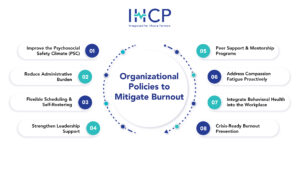Introduction: Understanding Burnout in the Healthcare Sector
Burnout is one of the most pressing challenges facing healthcare organizations today. The World Health Organization (WHO) officially classifies burnout as an occupational phenomenon—not a medical condition—resulting from chronic workplace stress that has not been successfully managed. For healthcare professionals, burnout is often fueled by excessive workloads, high emotional demands, inadequate staffing, administrative overload, and moral injury when unable to provide the level of care they know patients deserve.
Even before the COVID-19 pandemic, burnout rates among physicians and nurses were alarmingly high. Research from the Mayo Clinic revealed that nearly 50% of physicians experienced at least one major symptom of burnout. The pandemic amplified these numbers dramatically, adding trauma, isolation, and relentless uncertainty into the mix.
Burnout manifests through three primary dimensions:
- Emotional exhaustion – feeling emotionally drained and depleted.
- Depersonalization – developing a detached or cynical attitude toward patients.
- Reduced personal accomplishment – feeling ineffective and questioning one’s professional value.
The impact is twofold: healthcare workers suffer physically and mentally, and patients face higher risks of errors, reduced empathy, and compromised care quality. This makes addressing burnout a moral, operational, and financial imperative for healthcare organizations and healthcare consulting firms alike.
Identifying Early Signs and Symptoms
Proactively detecting burnout is far more effective than attempting to reverse it once it has fully set in. Early recognition allows organizations to intervene before staff members reach a breaking point.
1. Emotional Indicators
- Persistent fatigue, even after rest.
- Irritability or mood swings.
- Withdrawal from colleagues and team activities.
- Loss of empathy toward patients.
2. Behavioral Changes
- Increased absenteeism or lateness.
- Declining job performance or frequent errors.
- Avoidance of challenging tasks or interactions.
- Reduced participation in professional development.
3. Physical Symptoms
- Frequent headaches or muscle tension.
- Sleep disturbances.
- Gastrointestinal issues.
- Weakened immune response leading to more sick days.
Surveys, anonymous reporting channels, and confidential one-on-one check-ins can help organizations spot these patterns. Leaders should be trained to differentiate between temporary stress and systemic burnout, as the latter requires healthcare workforce management solutions rather than individual fixes.
Organizational Policies to Mitigate Burnout in Hospitals
Effective burnout prevention is rooted in organizational commitment rather than relying solely on individual coping strategies. Here are evidence-based policies and interventions that have been shown to work.
1. Improve the Psychosocial Safety Climate (PSC)
PSC refers to the shared belief that an organization values employee well-being. When healthcare workers perceive that their mental health is prioritized, they report lower stress, higher engagement, and improved retention.
Action steps:
- Conduct annual PSC surveys to measure workplace climate.
- Implement leadership training on psychological safety.
- Publicly recognize departments that model supportive practices.
2. Reduce Administrative Burden
One of the biggest contributors to burnout is time spent on paperwork rather than patient care. Studies indicate physicians spend nearly two hours on EHR documentation for every hour of patient interaction.
Action steps:
- Employ medical scribes to handle charting.
- Optimize EHR systems to reduce clicks and redundant data entry.
- Create a “Remove, Automate, Simplify” (RAS) task force to review and eliminate unnecessary forms.
3. Flexible Scheduling & Self-Rostering
Rigid scheduling ignores the reality of personal needs, family commitments, and rest cycles. Flexible scheduling can reduce fatigue-related errors and improve morale.
Action steps:
- Allow staff to trade shifts without penalty.
- Pilot self-rostering software that empowers employees to choose preferred shifts.
- Use predictive analytics to forecast patient demand and align staffing accordingly with medical staffing solutions.
4. Strengthen Leadership Support
Burnout thrives in environments where employees feel unsupported by their leaders. Transformational leadership—where leaders inspire, support, and advocate for their teams—is linked to lower burnout rates.
Action steps:
- Train leaders to recognize signs of distress and respond empathetically.
- Implement regular “pulse checks” to assess team morale.
- Hold leadership accountable for team well-being in performance reviews.
5. Peer Support & Mentorship Programs
Isolation exacerbates burnout. Structured peer support offers a safe outlet for processing stress and sharing coping strategies.
Action steps:
- Establish peer mentoring systems pairing experienced staff with newcomers.
- Offer debriefing sessions after traumatic events.
- Provide confidential peer-to-peer counseling services.
6. Address Compassion Fatigue Proactively
Compassion fatigue—a state of emotional numbness from prolonged exposure to suffering—can lead to severe burnout if unaddressed.
Action steps:
- Educate staff about compassion fatigue during onboarding.
- Offer resilience training workshops.
- Normalize mental health days without stigma.
7. Integrate Behavioral Health into the Workplace
Embedding mental health professionals within healthcare teams removes barriers to seeking help.
Action steps:
- Provide onsite counseling services.
- Partner with behavioral health providers for confidential support.
- Promote anonymous access to tele-mental health platforms.
8. Crisis-Ready Burnout Prevention
During emergencies like pandemics or natural disasters, burnout risks skyrocket.
Action steps:
- Create rapid response mental health teams.
- Rotate high-stress assignments to prevent overload.
- Offer immediate access to rest areas and nutritional support during crises.
Promoting Mental Health and Well-being in Healthcare Settings
Burnout prevention should be complemented by ongoing mental health promotion. These initiatives reinforce resilience and job satisfaction.
Resilience-Building Programs
Hospitals like Mount Sinai have implemented Stress & Resilience Centers offering workshops on mindfulness, breathing techniques, and positive psychology. Staff trained in these tools report lower stress and better coping skills.
Stigma Reduction Campaigns
Fear of professional repercussions keeps many clinicians from seeking help. Legislative initiatives like the Dr. Lorna Breen Health Care Provider Protection Act protect healthcare workers from licensing penalties when disclosing mental health treatment.
Lifestyle Support Initiatives
Encourage self-care by:
- Providing healthy meal options in staff cafeterias.
- Offering discounted gym memberships or onsite fitness classes.
- Designing rest spaces that promote relaxation and recovery.
Conclusion: Creating a Supportive Work Environment to Reduce Burnout
Burnout is a systemic issue that requires systemic solutions. Organizations must go beyond wellness slogans and integrate well-being into the operational DNA of the healthcare system.
A truly supportive workplace:
- Listens to employee feedback and acts on it.
- Removes structural stressors instead of placing the burden on individuals to adapt.
- Invests in leadership and culture change to prioritize well-being alongside patient outcomes.
By making healthcare workforce burnout solutions as critical a priority as patient safety, healthcare organizations can reduce turnover, enhance care quality, and sustain a thriving workforce.
At IHCP, we believe that caring for healthcare professionals is just as important as caring for patients. We work with healthcare organizations to design evidence-based burnout prevention programs, deliver healthcare leadership training, and implement operational excellence in healthcare strategies that protect and sustain your teams.
If your organization is ready to reduce burnout, improve retention, and create a culture of resilience, start the conversation with us today.
FAQs: Burnout Prevention and Workforce Solutions
1. How is burnout different from regular job stress?
Job stress is temporary and often situational, while burnout is a chronic, progressive state marked by exhaustion, detachment, and reduced professional fulfillment.
2. What’s the financial impact of burnout on organizations?
Burnout increases turnover, absenteeism, and malpractice risks, costing U.S. healthcare systems billions annually in lost productivity and recruitment expenses.
3. Can technology help prevent burnout?
Yes—AI-assisted documentation, automated scheduling, and healthcare workforce management tools can reduce workload and free up clinicians to focus on patient care.
4. Is burnout reversible?
Yes, with targeted interventions—reduced workload, increased support, and access to mental health support in healthcare—many professionals recover and re-engage.
5. How can smaller clinics apply these strategies?
Small organizations can adopt low-cost measures like flexible scheduling, peer mentoring, and community mental health partnerships







